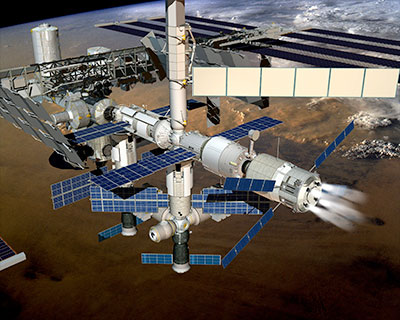|
Author
|
Topic: ISS 42: ATV-5 deboosting space station's orbit
|
Robert Pearlman
Editor Posts: 42988
From: Houston, TX
Registered: Nov 1999
|
 posted 01-28-2015 03:49 PM
posted 01-28-2015 03:49 PM
   
European Space Agency release ATV5: Putting the brakes on the ISSA concise update just in from Jean-Michel Bois, the ESA Mission Director at ATV-CC working on today's ATV propulsive support. We have been asked to use ATV-5 to decrease — a little — the International Space Station (ISS) altitude, by around 1 km [0.6 miles].  A lower orbit slightly increases the (already tiny) drag exerted by the wisps of atmosphere on the ISS and, therefore, also increases the decay of the ISS orbit. This allows the visiting vehicles (Progress, SpaceX, Cygnus, etc.) to bring up to station a heavier load. ATV-5 will be used Wednesday (Jan. 28) afternoon to 'put on the brakes', reducing the speed of the ISS so that it consequently will drop to new lower, but stable, orbit. The boost (in this case, 'deboost') has a value of 0.68 m/s and ran between 12:40 to 12:44:49 CST (18:40:00 to 18:44:49 UTC). It is the first time that an ATV has been used to decrease the altitude; usually, on the contrary, ATV propulsive support is used to lift the orbit due to the regular decay (around 1 or 2 km per month). To allow this maneuver, the ISS was turned 180 degrees so that the ATV, docked to the rear, was in front of the other modules with its thrusters directed opposite to the station's velocity vector. |
cosmos-walter
Member Posts: 691
From: Salzburg, Austria
Registered: Jun 2003
|
 posted 01-29-2015 10:27 AM
posted 01-29-2015 10:27 AM
   
A small correction: Satellites in lower earth orbits are faster than in higher orbits. |
Robert Pearlman
Editor Posts: 42988
From: Houston, TX
Registered: Nov 1999
|
 posted 01-29-2015 10:41 AM
posted 01-29-2015 10:41 AM
   
True, though what ESA states in its release is also true: the ATV slowed the space station to lower its orbit, which then resulted in a faster orbit. |
John C UK
Member Posts: 23
From:
Registered: Aug 2014
|
 posted 01-31-2015 07:26 AM
posted 01-31-2015 07:26 AM
   
Can someone explain to me how a lower and therefore faster orbit allows for more payload to be delivered from visiting supply craft? I'm writing a blog post, and I just cant reconcile it in my mind! Cheers. |
Robert Pearlman
Editor Posts: 42988
From: Houston, TX
Registered: Nov 1999
|
 posted 01-31-2015 07:46 AM
posted 01-31-2015 07:46 AM
   
The speed is not important, the altitude is. The lower the space station, the less fuel the visiting vehicle needs to reach it. The less fuel, the more cargo it can carry, trading the weight of the fuel for the weight of the cargo. |
sev8n
Member Posts: 234
From: Dallas TX USA
Registered: Jul 2012
|
 posted 01-31-2015 09:50 AM
posted 01-31-2015 09:50 AM
  
I (think) I understand the physics involved, but surely the ISS weighs orders of magnitude more than the resupply craft. How is it more efficient to lower the entire station than to boost the resupply higher? This is assuming the ISS will subsequently require a boost back up to a higher orbit, thus negating any savings... |
Robert Pearlman
Editor Posts: 42988
From: Houston, TX
Registered: Nov 1999
|
 posted 01-31-2015 11:54 AM
posted 01-31-2015 11:54 AM
   
The space station's altitude drives in part how much fuel visiting vehicles need to carry to get to the station. There is a weight tradeoff between how much fuel and how much cargo the vehicles can carry. If the station needs more cargo at a given time (such as due to the loss of a cargo craft and the subsequent delay of additional deliveries by that type of craft) then by lowering the altitude of the station, the visiting vehicle(s) can carry less fuel and more cargo. |
John C UK
Member Posts: 23
From:
Registered: Aug 2014
|
 posted 02-01-2015 03:58 PM
posted 02-01-2015 03:58 PM
   
Thanks for the replies. Makes sense. Interesting what goes on behind the scenes just keeping the ISS up there...
|
sev8n
Member Posts: 234
From: Dallas TX USA
Registered: Jul 2012
|
 posted 02-01-2015 04:57 PM
posted 02-01-2015 04:57 PM
  
quote:
Originally posted by Robert Pearlman:
There is a weight tradeoff between how much fuel and how much cargo the vehicles can carry.
So it's more a matter of fuel fraction? (or conversely, payload fraction) |












